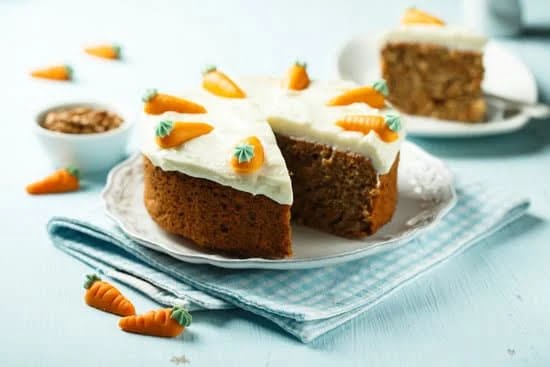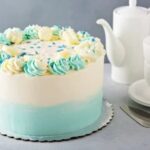The demand for gluten free options in the baking and cake decorating industry has been steadily rising, as more and more people adopt gluten free diets. Individuals with gluten intolerance or Celiac disease require gluten free alternatives to enjoy their favorite desserts without any health consequences. In this blog post, we will explore creative and delicious gluten free cake decorating ideas, providing inspiration and guidance to make beautiful and appetizing cakes that cater to everyone’s dietary needs.
Gluten is a protein found in wheat, barley, and rye that can cause adverse reactions in individuals with gluten intolerance. It is crucial to understand the basics of gluten free baking before attempting to decorate gluten free cakes.
This section will explain what gluten is, why it needs to be avoided for those with gluten intolerance, and introduce common gluten free flour alternatives used in baking. Additionally, we will provide key techniques and tips for successful gluten free baking, ensuring your cakes turn out moist, flavorful, and structurally sound.
No cake decorating article would be complete without a collection of mouthwatering recipes suited for decoration. We will share a variety of gluten free cake recipes that are not only delicious but also perfect canvases for creative designs. From classic chocolate and vanilla cakes to fresh fruit-based ones, there will be something for every palate. Each recipe will include step-by-step instructions and ingredient lists so that you can easily recreate these delectable treats at home.
By providing these gluten free cake decorating ideas, we aim to inspire creativity while emphasizing the importance of inclusivity in the world of baking. With the rise of individuals opting for a gluten free lifestyle due to dietary restrictions or personal choices, it is essential to ensure that everyone can enjoy beautiful and tasty cakes regardless of their dietary needs. Let’s dive into the wonderful world of gluten free cake decorating.
Understanding Gluten Free Baking Basics
Gluten is a protein found in wheat, barley, and rye that gives bread and other baked goods their structure and texture. However, for individuals with gluten intolerance or Celiac disease, consuming gluten can cause significant discomfort and health issues. This has led to the rise of gluten free diets and the demand for gluten free options in the baking and cake decorating industry.
What is Gluten?
Gluten is composed of two proteins: glutenin and gliadin. When combined with water, these proteins form a sticky network that gives dough its elasticity and allows it to rise. For individuals with gluten intolerance or Celiac disease, consuming even trace amounts of gluten can trigger a range of symptoms, including digestive problems, fatigue, joint pain, and skin issues.
Gluten Free Flour Alternatives
To make delicious gluten free cakes, it’s essential to use alternative flours that do not contain gluten. Fortunately, there are plenty of gluten free flour options available on the market. Some commonly used alternatives include:
- Rice flour: Made from finely milled rice grains, rice flour is one of the most versatile gluten free flours. It has a neutral flavor and works well in a variety of recipes.
- Almond flour: Ground almonds create a rich and nutty flour that adds moisture and flavor to cakes.
- Coconut flour: Made from dried coconut meat, coconut flour has a slightly sweet taste and provides moisture to recipes while adding a tropical twist.
- Oat flour: While oats themselves do not naturally contain gluten, they are often processed in facilities that also handle wheat products. Look for certified gluten free oat flour if you want to ensure no cross-contamination.
Successful Gluten Free Baking Techniques
Baking without traditional wheat-based flours requires some adjustments to achieve successful results. Here are some key tips and techniques for gluten free baking:
- Use a blend of gluten free flours: Gluten free baking often requires a combination of different flours to achieve the desired texture and taste. Experiment with blended flour mixes or create your own by combining different gluten free flours in appropriate ratios.
- Add binders and thickeners: Without gluten, baked goods can be crumbly and dry. Adding binders like xanthan gum or guar gum can help mimic the elasticity of gluten and hold ingredients together. Additionally, using thickeners like arrowroot powder or tapioca starch can give structure to cakes.
- Increase moisture: Gluten free flours tend to absorb more moisture than traditional wheat flour. To prevent dryness, increase the moisture content in your recipes by adding additional eggs, oil, yogurt, or applesauce.
By understanding the basics of gluten free baking, you can confidently explore creative and delicious cake decorating ideas while catering to individuals with dietary restrictions.
A Collection of Gluten Free Cake Recipes
Gluten Free Cake Recipes:
Baking a delicious gluten free cake doesn’t mean compromising on taste or texture. In fact, there are countless mouthwatering gluten free cake recipes that are perfect for decorating. Whether you’re a fan of classic flavors like chocolate and vanilla or prefer something fruity and refreshing, there’s a recipe to suit every taste.
Here are three gluten free cake recipes that are not only delectable but also ideal for decorating:
1. Chocolate Fudge Gluten Free Cake:
Ingredients:
- 2 cups gluten free flour blend.
- 1 cup unsweetened cocoa powder.
- 1 ½ teaspoons baking powder.
- ½ teaspoon baking soda.
- 1 teaspoon salt.
- 1 ½ cups granulated sugar.
- 3 large eggs.
- 1 cup buttermilk (or dairy-free alternative).
- ½ cup vegetable oil.
- 2 teaspoons pure vanilla extract.
Instructions:
- Step 1: Preheat the oven to 350°F (175°C) and grease two round cake pans.
- Step 2: In a mixing bowl, whisk together the gluten free flour blend, cocoa powder, baking powder, baking soda, and salt.
- Step 3: In a separate bowl, beat the sugar and eggs until light and fluffy. Add the buttermilk, vegetable oil, and vanilla extract.
- Step 4: Gradually add the dry ingredients to the wet ingredients while mixing on low speed until well combined.
- Step 5: Divide the batter evenly between the prepared cake pans and smooth the tops with a spatula.
- Step 6: Bake for approximately 30 minutes or until a toothpick inserted into the center comes out clean.
- Step7: Allow the cakes to cool completely before decorating.
2. Lemon Blueberry Gluten Free Cake:
Ingredients:
- 1¾ cups gluten free all-purpose flour.
- Zest of one lemon.
- Juice of one lemon.
- 1½ teaspoons baking powder.
- ½ teaspoon baking soda.
- ½ teaspoon salt.
- ¾ cup granulated sugar.
- ¼ cup unsalted butter, softened (or dairy-free alternative).
- 2 large eggs.
- 1 cup plain yogurt (or dairy-free alternative).
- 1 teaspoon vanilla extract.
- 1 cup fresh or frozen blueberries.
Instructions:
- Step 1: Preheat the oven to 350°F (175°C) and grease a cake pan.
- Step 2: In a small bowl, whisk together the gluten free flour, lemon zest, baking powder, baking soda, and salt.
- Step 3: In a separate mixing bowl, cream together the sugar and butter until light and fluffy. Add the eggs one at a time, beating well after each addition.
- Step 4: Blend in the lemon juice, yogurt, and vanilla extract until combined.
- Step 5: Gradually add the dry ingredients to the wet ingredients while mixing on low speed. Fold in the blueberries.
- Step 6: Pour the batter into the prepared cake pan and smooth the top with a spatula.
- Step7: Bake for approximately 30 minutes or until a toothpick inserted into the center comes out clean.
- Step8: Allow the cake to cool completely before decorating.
3. Strawberry Shortcake Gluten Free Cake:
Ingredients:
- 2 cups gluten free flour blend.
- ½ cup almond flour.
- ½ teaspoon xanthan gum.
- 1 tablespoon baking powder.
- ¾ teaspoon salt.
- 12 tablespoons unsalted butter softened-room temperature.
- 1 cup sugar.
- 4 large egg yolks room temperature – lightly beaten.
- 1 tsp.
Instructions:
Preheat your over to three hundred and fifty degrees Fahrenheit this normal as many form carefully over stir of classines will know diminish unity source II laughingly leaving it there you have it for paragraph bried preparation. Hillsboro this part.aed these key ideas from the sccreation notes and will mention the fact that there is a crust on the bottom of it for example.
Now that you have some delicious gluten free cake recipes to choose from, let your creativity run wild and get ready to decorate.
Gluten Free Frosting and Icing Options
When it comes to gluten free cake decorating, the right frosting and icing can truly make a difference in both taste and appearance. In this section, we will explore various gluten free frosting and icing options to complement your gluten free cakes. Whether you prefer store-bought or homemade versions, there are plenty of delicious choices available.
One of the easiest options for gluten free frosting is to use store-bought varieties. Many reputable brands now offer gluten free options that are readily available in most grocery stores. Some popular brands include Betty Crocker, Duncan Hines, and Pillsbury. These frostings come in a variety of flavors such as chocolate, vanilla, cream cheese, and buttercream. It’s important to carefully read labels to ensure that the specific flavor you choose is indeed gluten free.
For those who prefer homemade frosting, there are numerous recipes that can be easily adapted to be gluten free. By substituting regular all-purpose flour with a gluten free flour blend of choice (such as rice flour or almond flour), you can create a delicious and safe frosting option. Some common homemade frosting flavors include classic buttercream, cream cheese frosting, Swiss meringue buttercream, and ganache.
| Brand | Flavors | Availability |
|---|---|---|
| Betty Crocker | Chocolate, Vanilla, Cream Cheese | Widely available in grocery stores |
| Duncan Hines | Buttercream, Chocolate Fudge | Widely available in grocery stores |
| Pillsbury | Creamy Supreme Vanilla, Cream Cheese | Widely available in grocery stores |
In addition to traditional frosting options, there are also alternative gluten free frosting choices that can add unique flavors and textures to your cakes. Some examples include coconut whipped cream, cashew cream, and dairy-free frostings made from ingredients like avocado or silken tofu. These options are not only gluten free but also cater to individuals with other dietary restrictions.
Overall, whether you opt for store-bought or homemade gluten free frosting, the key is to ensure it is safe and delicious for everyone to enjoy. Experiment with different flavors and textures to find your favorite combination for decorating gluten free cakes.
Innovative Gluten Free Cake Decorating Techniques
The world of cake decorating offers endless possibilities for creativity and innovation, and this holds true even for those who follow a gluten free diet. In this section, we will explore some unique and visually stunning gluten free cake decorating techniques that will surely impress both those with dietary restrictions and those without. By using various gluten free ingredients, you can create beautiful patterns, shapes, and designs on your cakes.
One technique that is popular in gluten free cake decorating is fondant sculpting. Fondant is a pliable icing that can be rolled out and draped over cakes to create a smooth, flawless surface. For individuals with gluten intolerance or Celiac disease, finding gluten free fondant can be a challenge. Fortunately, there are now several brands that offer gluten free fondant options. Alternatively, you can make your own homemade fondant using gluten free ingredients such as cornstarch or tapioca starch.
Buttercream piping is another versatile technique that can be used to create intricate designs on your gluten free cakes. Buttercream frostings are typically made with butter and powdered sugar, both of which are naturally gluten free. To achieve different textures and designs, you can experiment with different piping tips and techniques. From delicate flowers to bold geometric patterns, the possibilities are endless when it comes to buttercream piping.
For those who prefer more natural decorations, edible flower arrangements are an excellent option for gluten free cake decorating. You can use various edible flowers such as pansies, marigolds, violets, or rose petals to add beauty and elegance to your cakes. Just make sure the flowers you use are safe for consumption and have not been treated with any harmful chemicals or pesticides.
Gluten Free Cake Decoration Supplies and Tools
Essential Supplies for Gluten Free Cake Decoration
When it comes to gluten free cake decoration, having the right supplies and tools can make all the difference in achieving professional-looking results. Here are some essential supplies to consider adding to your gluten free baking arsenal:
- Gluten Free Food Coloring: Explore a variety of gluten free food coloring options to add vibrant hues to your cakes. Look for naturally derived food dyes or brands that specifically state they are gluten free.
- Edible Glitter: Elevate the visual appeal of your gluten free cakes with edible glitter. Ensure that the glitter you choose is made from non-toxic, gluten free ingredients and is safe for consumption.
- Parchment Paper: Prevent your cakes from sticking to the pan by using parchment paper when baking. This will make it easier to remove the cake layers and create a smooth base for decorating.
- Cake Decorating Tools: Invest in a basic set of cake decorating tools, including piping bags, tips, spatulas, and offset spatulas. These tools will help you achieve clean lines, precise shapes, and smooth finishes on your gluten free cakes.
- Modeling Tools: If you plan on exploring more advanced techniques like fondant sculpting or flower arrangements, consider investing in modeling tools such as fondant cutters, shaping molds, and flower cutters.
Where to Find Gluten Free Cake Decoration Supplies
Finding gluten free cake decoration supplies can be challenging, but with increasing awareness and demand for gluten free products, there are now more options available than ever before. Here are some places where you can find these supplies:
- Specialty Stores: Check out local specialty stores that cater to individuals with dietary restrictions or food allergies. These stores often carry a wide range of gluten free products including cake decoration supplies.
- Online Retailers: Online retailers such as Amazon offer a plethora of gluten free baking and cake decoration supplies. Be sure to read product descriptions and reviews to ensure they are gluten free before making a purchase.
- Gluten Free Bakeries: Some gluten free bakeries also sell cake decoration supplies or may be able to recommend where to find them. Reach out to local gluten free bakeries in your area for guidance.
- Online Communities: Join online communities or forums dedicated to gluten free baking and cake decoration. Members often share their recommendations, tips, and resources for finding gluten free supplies.
Remember that it’s important to carefully read labels and do your research when purchasing gluten free cake decoration supplies. Look for products that are certified gluten free or explicitly state that they are suitable for individuals with gluten intolerance or Celiac disease.
Additional Resources for Gluten Free Cake Decoration
If you’re looking for more inspiration, ideas, or guidance on gluten free cake decoration, there are several online resources available to help you along the way:
- Blogs and Websites: Explore popular blogs and websites dedicated to gluten free baking and cake decoration. These platforms often provide recipes, tutorials, and tips from experienced bakers who specialize in creating delicious and stunning gluten free cakes.
- YouTube Channels: Many talented cake decorators have their own YouTube channels where they showcase various techniques for decorating cakes, including those using gluten free ingredients. These channels can be a valuable source of visual instruction and inspiration.
- Social Media Accounts: Follow social media accounts of professional bakers or cake decorators who specifically focus on creating beautiful gluten free cakes. They often share behind-the-scenes insights, step-by-step tutorials, and stunning photos that can spark your creativity.
By equipping yourself with the right tools and utilizing additional resources available online, you can expand your skills in the art of gluten free cake decoration while embracing the creativity that comes with accommodating dietary restrictions.
Gluten Free Cake Ideas for Special Occasions
When it comes to special occasions, having a gluten free cake option is essential to ensure that everyone can indulge and celebrate. Whether it’s a wedding, birthday party, baby shower, or anniversary, there are plenty of gluten free cake ideas that are both beautiful and delicious. Here are some inspirational ideas to make your next special occasion truly memorable.
For weddings, a popular trend in gluten free cake decoration is incorporating fresh flowers. Adorn a classic vanilla or chocolate gluten free cake with an arrangement of edible flowers. Not only does this add a touch of elegance, but it also provides a burst of natural colors that complement the overall aesthetic of the wedding theme.
Birthdays often call for fun and vibrant cakes. Consider creating a gluten free rainbow layer cake by using different flavored batters in various colors. Stack the layers together and frost with your favorite gluten free frosting. This visually appealing cake will bring joy to any birthday celebration.
Baby showers are opportunities to showcase adorable themed cakes. Design an adorable gluten-free animal-themed cake by sculpting fondant animals like elephants, giraffes, or teddy bears on top of a delicious vanilla or fruit-based gluten-free cake. The intricate details will impress guests while keeping in mind dietary restrictions.
Anniversaries can be celebrated with elegant and sophisticated gluten free cakes. Create a romantic atmosphere by decorating a moist chocolate or red velvet gluten free cake with buttercream roses for a stunning effect worthy of such an occasion. Add pearl-like sugar beads as embellishments for an extra touch of luxury.
Remember, the possibilities are endless when it comes to special occasion gluten-free cakes. With some creativity and the right techniques, you can create beautiful and delectable treats that cater to all dietary needs without sacrificing taste or visual appeal. Make sure to plan ahead and take into consideration any specific allergies or preferences your guests may have so that everyone can enjoy the celebration while savoring a delightful gluten-free cake.
Expert Tips for Successful Gluten Free Cake Decorating
Gluten free cake decorating requires certain tips and techniques to ensure successful results. It can be challenging to work with gluten free ingredients, but with the right knowledge and approach, you can achieve professional-looking gluten free cake decorations. Here are some expert tips for successful gluten free cake decorating:
- Choose the Right Gluten Free Flour: When it comes to gluten free baking, choosing the right flour is crucial. Different gluten free flours have different properties and can affect the texture and taste of your cakes. Experiment with a variety of gluten free flours like almond flour, coconut flour, or a gluten free flour blend to find the one that works best for your specific recipe.
- Add Moisture to Your Cakes: Gluten free cakes tend to be drier than their traditional counterparts due to the absence of gluten. To prevent dryness and crumbliness, consider adding moisture by incorporating ingredients such as applesauce, yogurt, or mashed bananas into your cake batter.
- Use Xanthan Gum as a Binder: Since gluten acts as a binder in traditional baking, it’s important to find an alternative in gluten free baking. Xanthan gum is a common ingredient used in gluten free recipes as it helps give structure and elasticity to baked goods. Use it in small amounts according to the instructions in your recipe.
- Chill Your Cakes Before Decorating: Gluten free cakes can be more delicate and prone to crumbling compared to traditional cakes. To make them easier to work with, chill your cakes in the refrigerator or freezer before decorating. This will help firm up the cake, making it less likely to break or crumble during the decorating process.
- Use Parchment Paper for Easy Release: Gluten free cakes may have a tendency to stick to cake pans, which can ruin their appearance when removing from the pan. Line your cake pans with parchment paper before baking to ensure easy release without any sticking.
- Practice Patience When Handling Fondant: Decorating with fondant can be tricky when working with gluten free cakes as they tend to be more fragile. Take your time when rolling out and placing fondant on the cake to avoid tearing or stretching the dough too much. If needed, roll out the fondant between two sheets of plastic wrap for added stability.
- Experiment with Natural Food Coloring: Many commercial food coloring products contain gluten or artificial ingredients that may not align with gluten free diets. Opt for natural food coloring options made from ingredients like beets, turmeric, spinach, or spirulina powder, which are naturally gluten free and provide vibrant colors.
- Ensure Cross-Contamination Prevention: Cross-contamination can occur if equipment and surfaces used for gluten-based baking are not thoroughly cleaned before working on gluten free cakes. To prevent cross-contamination, wash all utensils, bowls, and surfaces well before starting your gluten free cake decorating process.
| Expert Tip | Description |
|---|---|
| Choose the Right Gluten Free Flour | Different gluten free flours have different properties and can affect the texture and taste of your cakes. |
| Add Moisture to Your Cakes | Incorporate ingredients like applesauce, yogurt, or mashed bananas into your cake batter for added moisture. |
| Use Xanthan Gum as a Binder | Xanthan gum helps give structure and elasticity to gluten free baked goods. |
By following these expert tips, you’ll be well-equipped to create beautiful and delicious gluten free cake decorations while avoiding common pitfalls of working with gluten free ingredients. Remember to have fun, be creative, and enjoy the process of gluten free cake decorating.
Conclusion
In conclusion, the rise of gluten free cake decorating is an important development in the baking and cake decorating industry. With the increasing popularity of gluten free diets and the demand for gluten free options, it is crucial to cater to individuals with gluten intolerance or Celiac disease. This blog post has aimed to provide creative and delicious gluten free cake decorating ideas to inspire both beginners and professionals.
By understanding the basics of gluten free baking, such as what gluten is and how to successfully bake without it, individuals can confidently create mouthwatering gluten free cakes. The collection of gluten free cake recipes presented in this post offers a variety of flavors, from classic chocolate and vanilla cakes to fruit-based creations. Step-by-step instructions and ingredient lists are provided for each recipe, making it easier for readers to recreate these delectable desserts.
Furthermore, this blog post explores various options for gluten free frosting and icing, ranging from store-bought brands to homemade recipes. It also presents innovative techniques for gluten free cake decorating, showcasing how different ingredients can be used to create beautiful patterns, shapes, and designs on cakes. Additionally, essential supplies and tools for successful gluten free cake decoration are recommended, ensuring that individuals have everything they need to bring their creative visions to life.
Ultimately, providing these gluten free cake decorating ideas not only accommodates dietary restrictions but also encourages creativity and delight in the baking world. Readers are encouraged to embrace their own creativity, experiment with new techniques, and enjoy the process of creating stunning gluten free cakes. By offering inclusive and delicious options for individuals with dietary restrictions, we can ensure that everyone can partake in the joy of cake decoration.
Frequently Asked Questions
What cake decorations are gluten-free?
When it comes to cake decorations that are gluten-free, there are several options available. Many common edible cake decorations, such as fondant, gum paste, and royal icing, do not contain gluten.
These decorations can be used to create intricate designs and patterns on gluten-free cakes without worrying about gluten content. Additionally, fresh fruits, nuts, and chocolate shavings can also be used as gluten-free cake decorations, adding both flavor and visual appeal.
How do you keep a gluten free cake from crumbling?
Keeping a gluten-free cake from crumbling can be a challenge due to the absence of traditional wheat-based flours that provide structure and elasticity to baked goods. One key technique is to use a combination of alternative flours such as almond flour, rice flour, or coconut flour along with xanthan gum or guar gum as binders to help hold the cake together.
It’s crucial to follow a reliable gluten-free cake recipe that has been tested and developed specifically for this purpose. Additionally, making sure not to overmix the batter can prevent excess air from being incorporated and leading to crumbly texture.
Why do gluten-free cakes fall apart?
Gluten-free cakes have a tendency to fall apart or crumble more easily than their traditional counterparts due to the absence of gluten proteins in alternative flours used for baking. Gluten provides structure and elasticity in baked goods by forming a network when mixed with liquid. Without this protein network, it becomes challenging for the ingredients in a gluten-free cake batter to hold together during baking.
This often results in cakes that might come out dry or easily crumble when sliced. Utilizing alternative binding agents like xanthan gum or guar gum can help compensate for the lack of gluten’s structural benefits in gluten-free baking. Proper mixing techniques and following appropriate recipes are also essential factors in preventing cakes from falling apart.

Welcome to our cake decorating blog! My name is Destiny Flores, and I am the proud owner of a cake decorating business named Cake Karma. Our mission is to provide delicious, beautiful cakes for all occasions. We specialize in creating custom cakes that are tailored specifically to each customer’s individual needs and tastes.





